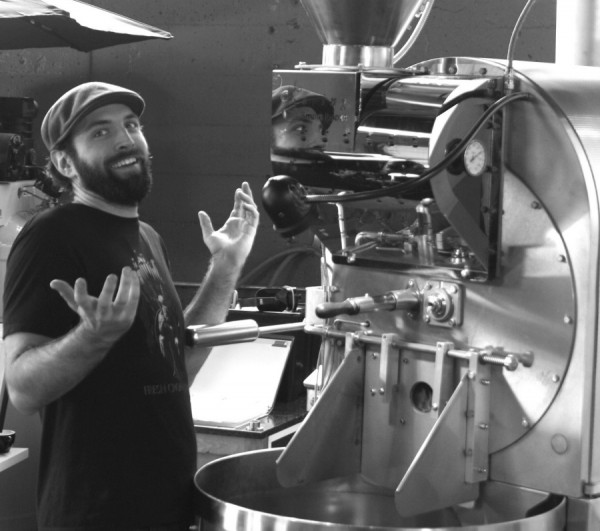Experienced roasters always seem to be straddling the line between, to borrow a phrase, the known knowns and the known unknowns. That dynamic is reflected in the very title of professional roaster, instructor and consultant Rob Hoos’s new book, Modulating the Flavor Profile of Coffee: One Roaster’s Manifesto. The book officially launched today, and is available here.
Modulating draws from Hoos’s experience as a roaster for commercial operations of various sizes with many different types of equipment. From that experience, he forms his manifesto, which is in part derived from the known knowns. Early on, he writes:
I have been as precise, objective and analytical as I can be with my current equipment. Readers should be able to take my experiments and reproduce them to test my theories and paradigms. I have been working with this approach for the past three years and have found it to be true regardless of roaster manufacturer, batch size, origin, altitude, etc. I hope that these standards can help you as much as they have helped me.
From there, Hoos acknowledges the unknowns:
With something as complex as coffee, I recognize that the nuance, and thus the conversation, is never over.
While some roasters can lean toward secrecy after developing roasting methodologies over a course of years, Hoos has always leaned toward education. In addition to his own consultancy, Hoos has been deeply involved in professional development education and instruction, specifically with the the SCAA and the Roasters Guild. He is currently the lead roaster at Portland-based Nossa Familia Coffee, where over the past three years he has logged more than 7,500 roasts. From those logs and associated observations come the bulk of this book.
We were able to catch up with Hoos just prior to Modulating‘s launch:
The big question is, “Why this book?” How do you see this fitting into the existing catalogue of in-depth writing on roasting methodology?
Part of the reason I wrote this book is to document and clarify, through the act of writing, my current approach to roasting coffee. I have always found that writing causes me to focus more thoroughly on the subject matter.
Another part is, I believe that I have stumbled into some novel, interesting, and compelling ideas that I would like to put out there for the world.
Yet another part is because I really enjoy acting as a consultant with roasters and helping them go to the next level, and I hope this book drives some new and interesting consulting gigs.
A big part is because of my experience when I was beginning to roast coffee. I found myself in a sort of vacuum of information about coffee and coffee roasting. Though there were books out there on how-to or home-roasting — usually more general ones — there was little to nothing out about how to manipulate the flavor of the coffee through varying the profile of the coffee while it is roasting.
Some of it could be secrecy, but as I have been working as a consultant and volunteer educator, I have found that there is just not much information out there on the subject. So, around the end of 2011, I decided I was going to do my best to experiment with the roast profile of coffee, compare it to cupping notes, and see what trends appeared in the data. Then I did this over different origins, different varieties, different roasters, and found that these trends held true.
What separates this book from others on the market is in-depth discussion of how I manipulate the roast profile to alter the taste of the roasted coffee I am serving. It doesn’t make recommendations — it just talks about causes and effects.
Apart from yourself, who is the book for?
It is geared primarily toward people who use professional equipment and roast coffee for a living, though it is applicable to home roasting, as well. I started out as a home roaster and would love for them to find the book helpful and informative. Some of it may be frustrating, depending on the level of control and data-feedback they have access to, but I think overall it will be an enjoyable book for professional roasters, as well as home-enthusiasts. Many times, home enthusiasts can be just as particular, if not more so, than people that roast for a living.
In the context of the book’s title and of coffee roasting, what do you mean by “modulation?”
Google does quite well in saying, “to exert a modifying or controlling influence on.” The premise behind the book is to take intentional control over the roast profile. The profile is a graph of the coffee moving through different chemical and physical changes over time. To intentionally control or “modulate” the profile is to take the coffee through the chemical/physical reactions to the duration and intensity that you deem to be appropriate or “best.” The key is to be intentional, to be controlled, and to understand how the changes you are making to the curve from one roast to the next are changing the flavor of the coffee.
Nick Brown
Nick Brown is the editor of Daily Coffee News by Roast Magazine.
Comment
2 Comments
Comments are closed.








I have had the pleasure of reading this book and can say that the Related Readings pale in comparison to this achievement. This is a wonderful work; backed up by science, cupping, and observations. For anyone willing to take the next step in their roasting journey and craft something wonderful, this is a must.
Is that book available in South Each Asia region? Indonesia or Singapore? I would like to purchase it. Thank you.